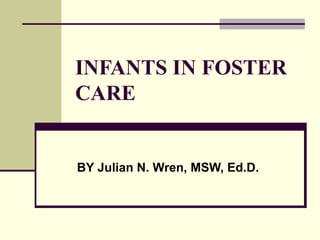
Infants in foster care
- 1. INFANTS IN FOSTER CARE BY Julian N. Wren, MSW, Ed.D.
- 2. Number and Percent of First Admissions by Age at Entry Nearly a third of the children entering foster care are under one year old.
- 3. Gender Distribution Infants are much more likely (53%) than older children (42%) to be female.
- 4. Race/ethnicity Distribution Infants are more likely than older children to be White (51%) or Black (16%).
- 5. Start Type Distribution Infants are much more likely (86%) than older children (72%) to experience foster care as their firs placement type.
- 6. Predominant Placement Type Count Predominant placement type Congregate Care Foster Care Kinship Care Other Placement Mixed Total Under 1 0 53 17 0 0 70 Over 1 3 169 67 10 2 251 Percent Under 1 Over 1 0% 1% 76%67% 24%27% 0% 4% 0% 1% 100%100% Infants are more likely (76%) than older children (67%) to experience non-relative foster care as their predominant placement type.
- 7. Does Infant’s length of stay in foster care differ from older children’s length of stay? (Infants admitted into foster care in 2010) Table 6: Median Days to Exit from Foster Care
- 8. Length of Stay Comparison Children who enter as infants have en equal median length of stay to older children (414). However, children who enter as infants exit care much slower than older children in the first 400 days. After that, the rate of exit for infants increases greatly and the exit rate of older children decreases (the lines cross and the brown line falls below the blue line.
- 9. Exit Event from Foster Care Count Exit Event Percent Under 1 Over 1 Under 1 Over 1 Completed Adoption 39 77 56% 31% Exit to Family 28 127 40% 51% Exit to Relative 0 7 0% 3% Runaway 0 8 0% 3% Reach Majority 0 3 0% 1% Other 0 2 0% 1% Still in Care 3 27 4% 11% Total 70 251 100% 100% Infants are more likely (58%) than older children (31%) to exit care to adoption.
- 10. Time to Reunification with Family (Months) Count Time to Reunification with Family Percent Under 1 Over 1 Under 1 Over 1 Less than 90 Days 8 33 29% 26% 3 to 6 months 1 12 4% 9% 6 to 12 months 11 34 39% 27% 1 to 2 years 8 46 29% 36% 2 to 5 years 0 2 0% 2% More than 5 years 0 0 0% 0% Total reunited with family (percent is the percentage of total selected spells) 28 127 40% 51% When infants do reunify with their families, they reunify much faster. Whereas 72% of the infants reunified went home within 12 months, only 62% of older children who reunified went home in that period of time.
- 11. Placement Stability Placement Stability (# of movements within spell) Under 1 Over 1 Under 1 Over 1 No movement 29 103 41% 41% One movement 32 100 46% 40% 2 to 3 movements 7 35 10% 14% 4 to 10 movements 2 13 3% 5% More than 10 movements 0 0 0% 0% Total 70 251 100% 100% Infants’ placements are slightly more stable than those of older children. Whereas 87% experience less than 2 movements, 81% of older children experienced less then 2 movements.
- 12. Re-Entry Infants are much less likely (5%) than older children (10%) to experience re-entry into foster care in the 12 months following exit from foster care.
- 13. Findings Summary: 1) Nearly a third of the children entering foster care are under one year old. 2) Infants are much more likely (53%) than older children (42%) to be female. 3) Infants are more likely than older children to be White (51%) or Black (16%). 4) Infants are much more likely (86%) than older children (72%) to experience foster care as their first placement type. 5) Infants are more likely (76%) than older children (67%) to experience non-relative foster care as their predominant placement type.
- 14. Findings Summary: (cont’d) 6) Children who enter as infants have en equal median length of stay to older children (414). However, children who enter as infants exit care much slower than older children in the first 400 days. After that, the rate of exit for infants increases greatly and the exit rate of older children decreases (the lines cross and the brown line falls below the blue line. 7) Infants are more likely (58%) than older children (31%) to exit care to adoption. 8) When infants do reunify with their families, they reunify much faster. Whereas 72% of the infants reunified went home within 12 months, only 62% of older children who reunified went home in that period of time. 9) Infants’ placements are slightly more stable than those of older children. Whereas 87% experience less than 2 movements, 81% of older children experienced less then 2 movements. 10) Infants are much less likely (5%) than older children (10%) to experience re-entry into foster care in the 12 months following exit from foster care.